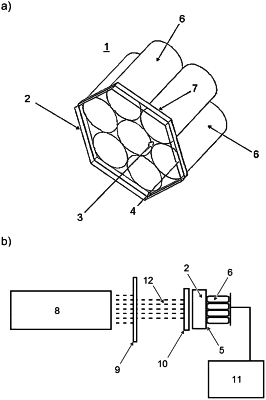| CPC G01T 7/005 (2013.01) [G01T 1/2018 (2013.01); G01T 1/202 (2013.01); G01T 1/2964 (2013.01)] | 18 Claims |

|
1. A system for detecting X-rays or gamma-rays, said system comprising:
a) at least one X-ray or gamma-ray detector comprising: (i) at least one scintillator crystal having a front surface, a back surface, and one or more edge surfaces, wherein said scintillator crystal is able to generate scintillation photons in response to an interaction event between a portion of the scintillator crystal and said X-rays or gamma-rays, and (ii) one or more photodetectors in optical communication with the at least one scintillator crystal, said one or more photodetectors able to receive generated scintillation photons exiting the at least one scintillator crystal and generate electrical signals in response to said received photons;
b) means for illuminating selected regions of the at least one X-ray or gamma-ray detector with an X-ray beam or gamma-ray beam; and
c) a microprocessor configured to receive electrical signals generated by the one or more photodetectors and generate data corresponding to positions of the interaction events between the X-ray beam or gamma-ray beam and the scintillator crystal, wherein said microprocessor is further configured to:
(i) illuminate the at least one X-ray or gamma-ray detector with a first X-ray beam or gamma-ray beam in a first defined region in the at least one X-ray or gamma-ray detector, and generate a first dataset, wherein the first dataset comprises data corresponding to positions where the first X-ray beam or gamma-ray beam interacts with the at least one X-ray or gamma-ray detector;
(ii) illuminate the at least one X-ray or gamma-ray detector with a second X-ray beam or gamma-ray beam in a second defined region in the at least one X-ray or gamma-ray detector, and generate a second dataset, wherein the second dataset comprises data corresponding to positions where the second X-ray beam or gamma-ray beam interacts with the at least one X-ray or gamma-ray detector;
(iii) identify positional data subsets that are common to both the first and second datasets, and generate a mean detector response function (MDRF) for the at least one X-ray or gamma-ray detector from the common positional data subsets; and
(iv) perform an imaging scan of an object utilizing the at least one X-ray or gamma-ray detector, estimating the position of each interaction event within the detector, and generating, enhancing and/or adjusting an image based on the generated MDRF.
|